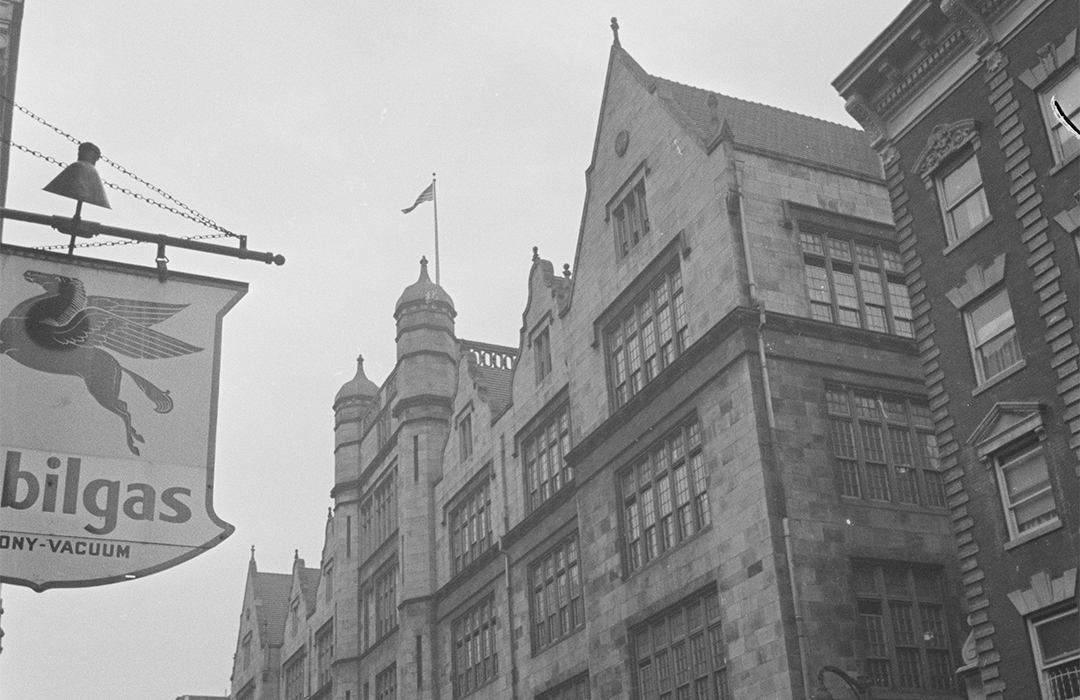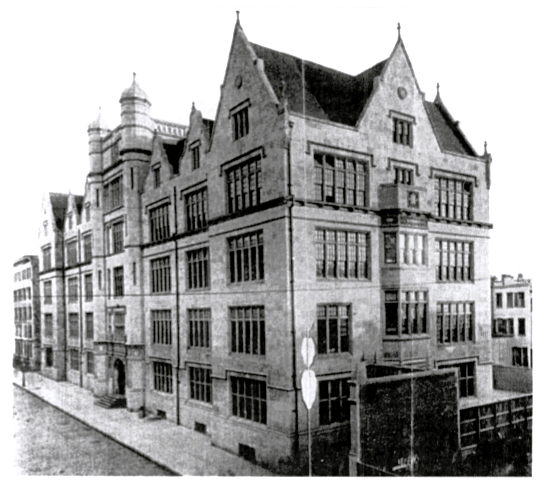
P.S. 166, 132 West 89th Street
by Tom Miller
When Charles B. J. Snyder was appointed Superintendent of School Buildings—a title equivalent to official school building architect—in 1891, he had a busy career ahead of him. The city was expanding at such a rate that the Board of Education was playing an impossible game of catch-up in terms of providing schools. The Annual Report of the Board of Education in 1896 reflected the problem. “The unprecedented growth of the city, together with the unexpected movements of population, rendered it almost impossible to keep pace with the demands in given localities or to anticipate the needs of certain sections of the city that speedily outgrew the accommodations that were provided.” And perhaps no area was so greatly affected as the Upper West Side.
In August 1897, Snyder laid plans for Public School 166 at 132 West 89th Street. Completed two years later, the immense edifice was designed in the Collegiate Gothic style, inspired by the distinguished educational institutions of Britain. Its five stories were clad in white terra cotta and terminated in gables and turrets.
All the boys in Public School 166 were required to take a course in manual training.
In 1903 the building began serving not only students, but the local community at large, by hosting free lectures. On December 9, the New-York Tribune reported, “Unusual interest is attached to the course of free lectures to be given under the auspices of the Department of Education, at Public School No. 166.” They began with six illustrated lectures on French history, by Dr. J. T. Shotwell of Columbia University.
All the boys in Public School 166 were required to take a course in manual training. On June 28, 1903, The New York Times remarked, “A large number of the pupils at that school have done supplementary work that is not a part of the prescribed course, but is taken up by the pupils voluntarily on the outside.” Two such pupils were Willie P. Jones and Harold Trimm both 13 years old. The youngsters had toiled every day after school for three weeks, finally producing a scale model of the U.S. warship the Terror which they lugged to school. The article said, “The vessel, bristling with a cannon that projected from stationary and revolving turrets fore and aft, and flying the National colors from her tall masthead, attracted the attention of every visitor to the workshop.” Not only was the miniature Terror correct in detail, but the cannon fired blank cartridges that produced puffs of smoke.
Alfred Cerimedo was a student at Public School 166 in 1916. That year in December he played the part of Bob Acres in Richard B. Sheridan’s The Rivals, presented at the De Witt Clinton High School. The remarkable thing about the cast—all of them pupils in city schools—was that each of the actors was blind. Alfred, like his cast mates, was “encouraged to do dramatics because the instructors all think nothing could be better for blind children than acting.” Exactly how the blind students were instructed throughout their regular class schedules is unclear; however, The Sun reported, “They are all, their teachers say, keeping up with their classmates, the sighted pupils, and apparently enjoying their school life just like any normal child.”
Public School 166 kept abreast of technology, and in February 1922, introduced the Radio Club of Public School 166. “The club was formed to promote interest in radio among the older boys in the school,” reported Radio News in its April-May 1922 issue.
Teaching here in 1932 was Miss Aigletinger, and among her eighth-grade students that year was Jerome D. Salinger.
Teaching here in 1932 was Miss Aigletinger, and among her eighth-grade students that year was Jerome D. Salinger. He was, according to New York Magazine decades later, “no star. He won no academic prizes and missed the honor roll.” Nevertheless, J. D. Salinger would go on to become one of America’s best-known authors. And he apparently never forgot Miss Aigletinger. In his 1951 novel The Cather in the Rye, after the character Holden Caulfield kills time in the Museum of Natural History, he comments, “I knew that whole museum routine like a book. We had this teacher, Miss Aigletinger, that took us there damn near every Saturday.”
Author J. D. Salinger was, by far, not the only famous and successful graduate of Public School 166. Others include Jonas Salk, who developed the polio vaccine; composer Richard Rodgers; singer and songwriter Melissa Manchester; museum designer (and husband of Caroline Kennedy) Edwin Schlossberg; and artist Everett Raymond Kinstler among others.
Just as it had embraced the new technology of radio, in the 1960s Public School 166 was one of the first in the city to establish a computer program. It was designated a magnet school in the 1980s, with a focus on arts and sciences. After an extensive renovation in the mid-1990s, it was rechristened the Manhattan School of Arts & Technology. The school was renamed again in 2003, now the Richard Rodgers School of Arts & Technology. Many New Yorkers (being New Yorkers), however, still refer to it as P.S. 166.
Tom Miller is a social historian and blogger at daytoninmanhattan.blogspot.com



